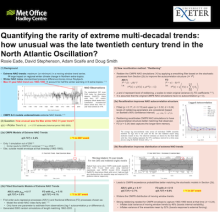Quantifying the rarity of extreme multi‑decadal trends: how unusual was the late twentieth century trend in the North Atlantic Oscillation?
Rosemary
Eade
Met Office, UK
Poster
Climate trends over multiple decades are important drivers of regional climate change that need to be considered for climate resilience. Of particular importance are extreme trends that society may not be expecting and is not well adapted to. This study investigates approaches to assess the likelihood of maximum moving window trends in historical records of climate indices by making use of simulations from climate models and stochastic time series models with short- and long-range dependence. These approaches are applied to assess the unusualness of the large positive trend that occurred in the North Atlantic Oscillation (NAO) index between the 1960s to 1990s. By considering stochastic models, we show that the chance of extreme trends is determined by the variance of the trend process, which generally increases when there is more serial correlation in the index series. We find that the Coupled Model Intercomparison Project (CMIP5 + 6) historical simulations have very rarely (around 1 in 200 chance) simulated maximum 31-year trends greater than the observed maximum. The winter NAO index has weak positive serial correlation which is underestimated in historical climate models and helps to explain the underestimation of extreme trends. Stochastic model best fits to the observed NAO suggest a greater chance (around 1 in 20) for there to be maximum 31-year NAO trends as large as the maximum observed since 1860. This suggests that current climate models do not fully represent important aspects of the mechanism for low frequency variability of the NAO. Post-processing methods are proposed to increase the low serial correlation in climate models and are shown to improve the simulation of extreme trends and also increase the variance of ensemble mean trends.

Poster file
eade-rosemary-confronting-poster.pdf
(981.75 KB)
